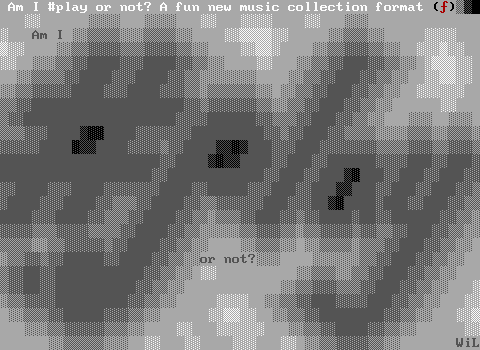A Good First Try...
Funk's initial foray into ZZT isn't half bad really! It effortlessly avoids many of the issues that typically plague first releases. You'll find plenty of ammo, health, and other supplies all over the place. Stars are used incredibly sparingly, and Funk has some novel ideas on how to make them work rather than overwhelm.

The game looks decent enough. No yellow borders left lingering around. A few boards from Super Tool Kit are imported towards the end of the file, and so the later boards are able to implement some standard solid-to-water shading. Funk has also taken the effort to return to earlier boards and dress them up a tiny bit as well. Towards the end of the game players do get to see some more impressive visuals. The exterior board for the elder's home is about as impressive as it gets, with its enormous size and animated puffs of smoke emanating from the chimney.
Compared to other contemporary releases Funk is certainly lagging behind more established ZZTers in the graphics department. Games like End of the World, Nightmare, and Warlord's Temple really highlight what ZZT games could look like when designed with STK in mind from the start. But then, why should it? Lost Crusaders is Funk's first release, striving to reach the level of those more notable titles, but not yet having done so. By this time, STK itself still isn't a (practical) guarantee at all, especially for those just discovering ZZT.

Where Funk is able to truly excel is in how he uses STK to present clear information to players during fights with ZZT's usual baddies. Players can bring Indy to the local zoo where Funk has gone all out with the exhibits.
There's likely inspiration here from the museum seen in Aceland. Both games present the creatures more in-universe than aimed directly at the player behind the keyboard. Funk doesn't stop at a sentence or two, writing detailed entries about how bears will hoard gems, this particular species of shark not dying if it stops swimming, and even throwing in a reference to Goosebumps stating that ZZT's slimes have been illegally sold to children as "Monster Blood". Plenty of ZZT games take the time to build up their enemies to make them more than an ASCII character. Funk has a great time finding ways to make describing ZZT's lions a little more exciting.
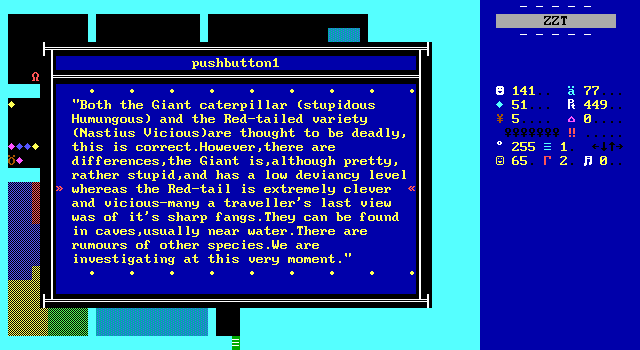
Most impressive of all though, is the zoo's revelation that different colored enemies will have different behaviors. Multi-colored centipedes have low deviance, while the red-tailed variety are highly aggressive and will turn freely, making them fierce hunters. Tigers use the default cyan for the bullet variety, with brown tigers being the dreaded star throwers. Funk's description acknowledges the fear these beasts invoke and spends some time commenting on the currently-unexplained biology that allows them to throw stars of course.
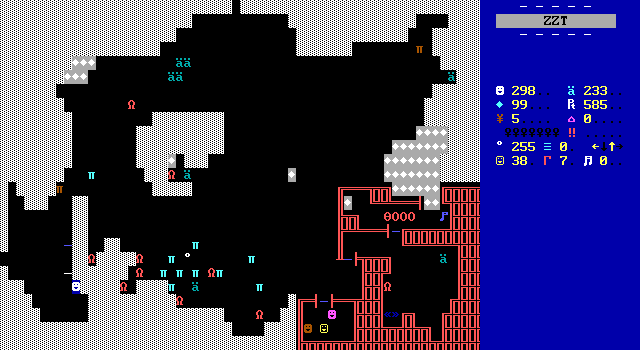
The game's few animal encounters abide by the rules presented here, with the tiger coloration having a considerable impact on how you aim. Funk wisely uses very few brown tigers, but just seeing one in the crowd is enough to make you shift focus with your aim rather than unthinkingly blast into the crowd. It's a smart use of built-ins further enhanced by giving the player a way to differentiate their customizable properties.
Funnily enough, with one exception. Lions are specifically exempt from having alternate colors, with their zoo exhibit lamenting that it can be difficult to tell if you're dealing with lions of high or low intelligence stats until they're already upon you. Funk manages to make color variances important and then emphasizes that further by taking that away from one of the creatures! This is a really well-executed idea, and not at all something you'd expect to see in a first release.
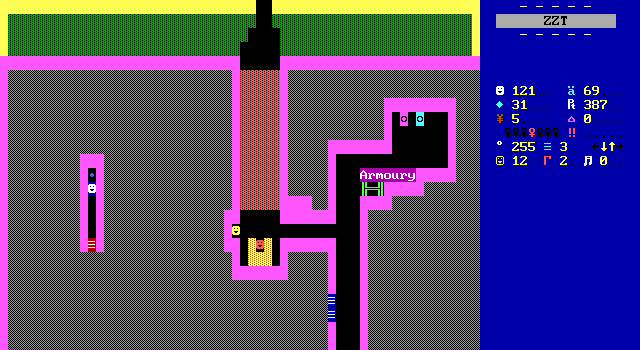
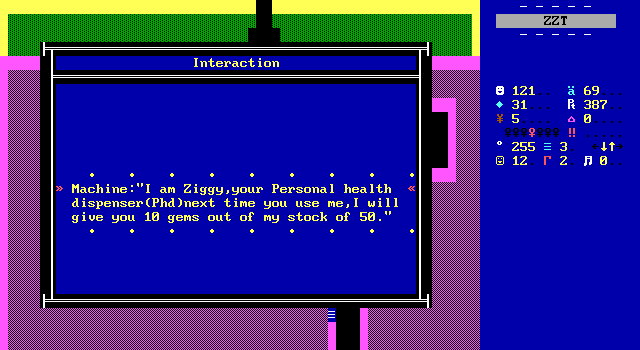
Lots of the game's appeal stems from Funk's introduction of original ideas like this. The creatures are the best of these, working rather well. Funk is loaded with ideas that he's eager to see realized in Lost Crusaders. The game features an armoury where players can grab gems and ammo to get their adventure underway. Rather than make players vacuum up piles of gems, or grab a box of bullets, Funk creates something close to vending machines. These machines are free to use, and have ~personality~. Interacting with each of the two has a voice accompany the items' delivery, dutifully reporting how much they have in reserve. Thematically, it's a bit weird for Indiana Jones and robots to be in the same space[1]. Every instance of a robot in this game feels less like Funk trying to add something new (if unnecessary) to an Indiana Jones games and more like also wanting to make a game akin to Robots of Gemrule
They even warn about calling a technician to order a refill, and to not operate the device when the stock has run out due to the potential for injury. Thankfully, that's merely a joke and attempting to use an empty machine won't harm Indy. It's just a fun way to give the player their usual supplies. Realistically, players should just empty both machines immediately, but due to the unusual way supplies were handed out, I found myself not wanting to just exhaust them. For once, the items in a ZZT game didn't feel like they were mine and mine alone.
Oh, and the gem machine doubles as a healing device. This is a rare instance of a ZZT game using gems for health that also makes sure to increase your health when gems are acquired via #give. No score though. My kingdom for a ZZT game that truly acts like the player collected a bunch of gems when handing them directly to players.
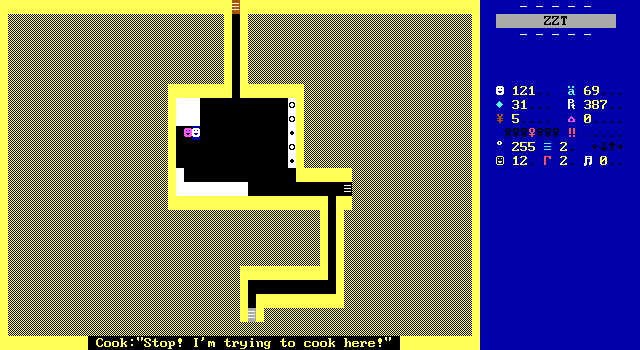
Finally, it's worth praising the structure of the game in general. After a quick introduction, Funk quickly guides the trapped Indy out of the collapsed mine and into the underground city. Afterwards, you're pretty much just set loose, free to explore basically anywhere. You don't even have to actually speak with the king until you're ready to explore the palace. Granted, not taking listening to the guard's instructions to head there first may make for a very confusing experience.
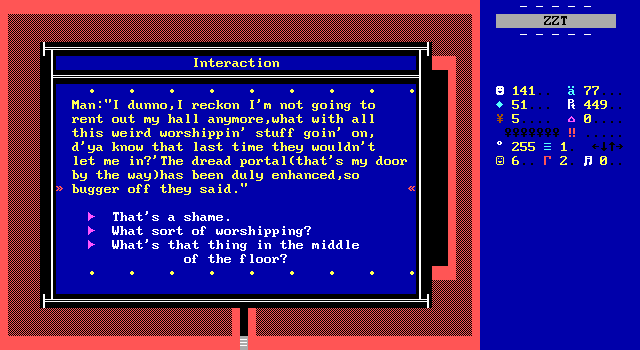
But the underground city that Funk builds is fun to explore. Players can usually learn something important, find one of the missing bank keys, or end up in a shootout whenever they enter a new location. The specific locations are standard places you'd expect a city to have: apartments, the bank, a school, a church, etc. A lot of ZZTers fall into the trap of including these buildings solely because they belong in cities in real life, not caring whatsoever if the building has a reason for players to want to go there. (See Nature's Revenge). Funk manages to give almost every location a purpose, including NPCs that provide relevant information rather than generic rambling, or something hidden deeper inside that will make a location relevant later on in the game.
He does a good enough job, that in the rare instance where he doesn't, it stands out. In this case it's the school where a teacher is asking students about roman numerals while two in the back have a pea-shooter fight (with bullets Indy needs to dodge to cross). Since the rest of the game had done such a good job of making every space have purpose, the disappointment didn't even set in immediately. I instead assumed that there would be some puzzle later on where knowing my Roman numerals would be relevant only to eventually discover that no such puzzle existed.
Even this isn't so bad as Funk also has figured out that not every board needs to fill up all the allotted space. This is something very few ZZTers pick up on so early, and drags out so many early titles where a house with one person to talk to will cover the entire board. With Funk, being able to quickly get in and out of any location is prioritized, and when you do find yourself in a larger environment, there are things to do that necessitate the size.
For a first release, Funk in many ways surpassed my expectations.
...Still A First Try
That being said, it is still a first release, even if it's of unusually high quality. Certainly there's more to be won over by that deterred from, but players will run into a few little things here and there.
Again, compared to most first releases, this is rock solid material. The nitpicks are few, mostly worth noting because they're the kind of issues that are easily avoided once you're experienced enough to know to look out for them.
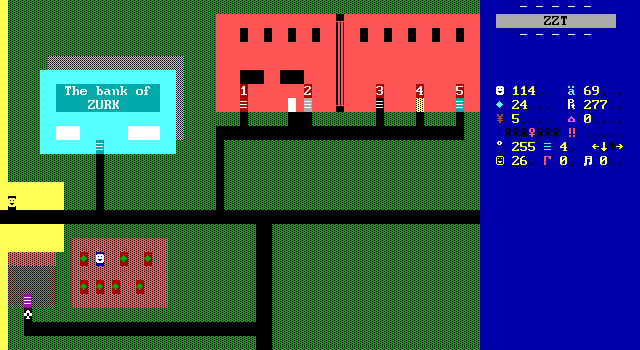
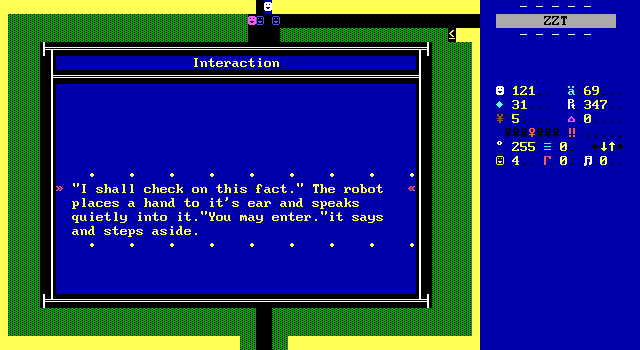

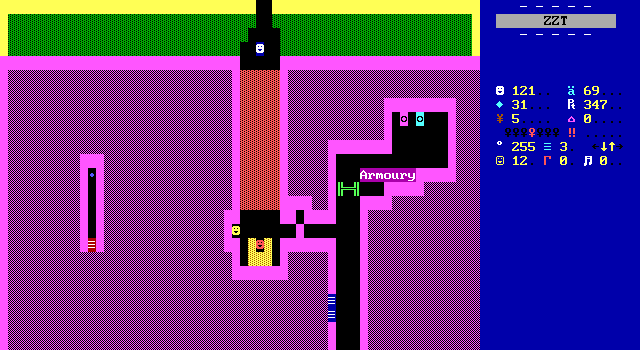
Probably the most annoying issue players will come up against is some spotty board connections. Not in the sense where you might walk onto a board and be unable to leave, or a two tile-wide exit that only lines up with the next board on one tile. I'm talking rooms with borders and a gap in the middle, whose other side has a perfectly aligned gap in the middle, but no border at all. If you stick to the roads, you'll never have any trouble, but if you're going your own way, you might run into an abrupt halt. All this needs is a matching border and there'd be no trouble here.
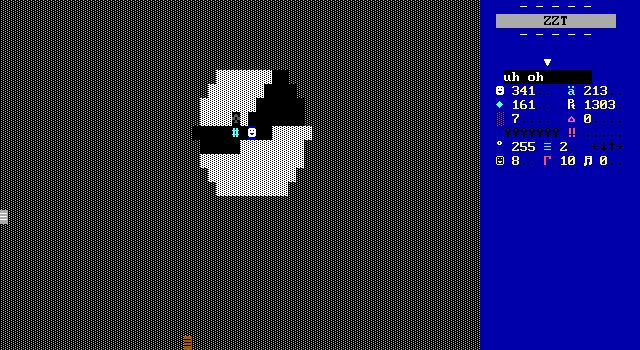
Towards the end of the adventure, I had the bad luck of a bat positioning itself into the groove a door was meant to open into. This caused the bat to be trapped, and the door to become stuck half-open, needing the ?ZAP cheat to keep the game going.
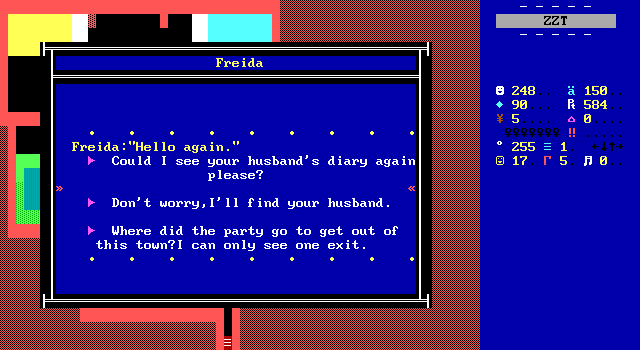
In one instance, I found myself unsure of how to proceed in the game, seemingly having exhausted all my options. I had to dig through the code to discover that a flag I needed wasn't set because I hadn't actually fully completed a conversation with Freida. After rescuing her, she explains to Indy that they were after her husband's bank vault key. She then sits down in the living room where players can talk to her a second time to be given her missing husband's diary that mentions their party being captured while on an expedition to a nearby cave. The cave seemed to be the obvious choice of where to go, but I was unable to find out how to actually get there. Turns out you need to talk to her a third time to ask her how her husband was able to leave the town if there's only the one exit.
I like what Funk did going from the first to the second conversation. Frieda is originally cornered by Nazis, and once rescued she needs to sit down, and walks off. The change in her location makes it sensible to speak with her again to see what else she might say. Afterwards though, it seems like you're given the clue you need for where to go next, only to realize you can't actually go anywhere new yet. I wish Indy would have just asked how Mr. Frieda left town the moment he saw the diary entry.
Another pacing issue happens with the cave itself. Players have to head through the palace, down to the wine cellar, and activate a secret passage to get there. From there the final bank vault key is found as well as the locked home of the head elder. You then need to go all the way back to town, enter the bank, fight a handful of ruffians (the one thing that tries to justify this walk), and grab the key to the elder's home before venturing all the way back to proceed one board deeper than before.
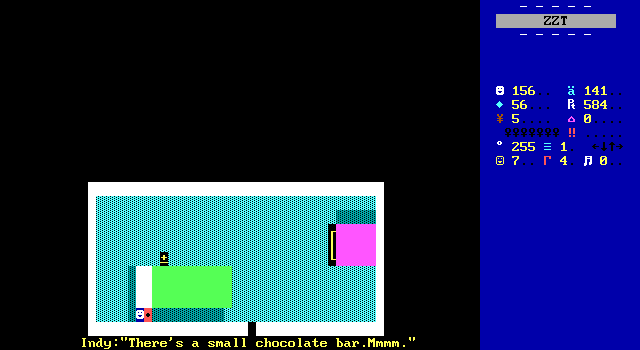
And sometimes it's just a little thing, like this chocolate bar. Indy can find it left as a snack in one of the guest bedrooms and eat it to restore a bit of health. The object doesn't go away after eating though! Feel free to gorge yourself on infinite chocolate.
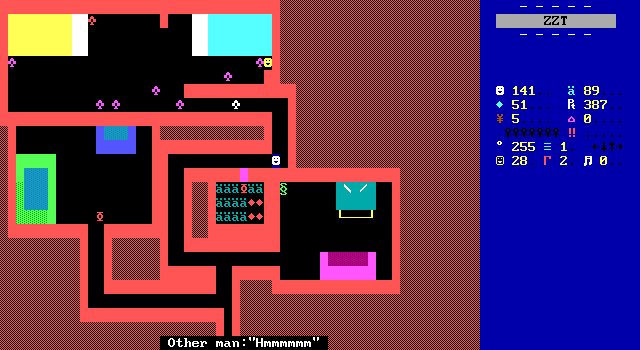
Frieda's home also has some annoyance in the form of two special enemies. The fiend directly assaulting Frieda looks like all the other ruffians the player will fight, though he doesn't actually move. Still, with the number of identical foes grouped together it's easy to not notice and assume he's just a regular ruffian currently in its resting state. If you should happen to shoot them, deliberately or not, the man survives thanks to his convenient armor, turns around, and throws a knife into Indy's throat, killing him instantly.
I had a save with a bullet traveling directly towards this game over.
Then the other special object on the board is the opposite! This one is red and clearly an object, but doesn't actually fight Indy, so it's only sensible to try touching before shooting. Nope. Shoot him and he dies on the spot. Touch him and Indy gets punched in the throat before the man calls for backup which carries Indy away where he spends the rest of his life as the shoe-shine boy for Hitler!
It's too arbitrary, with nothing to guide the players to the correct solution other than trying one and either dying or succeeding.
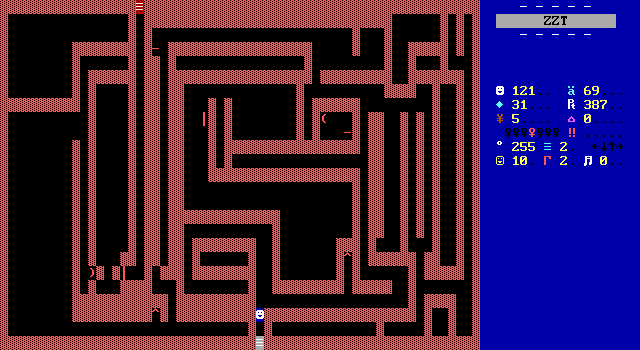
Also this board? I don't get this board. There is a cohesion seen throughout the rest of this game, but this room is what you get when you enter one of the passages in the palace. The rest are like guest bedrooms, a dining hall, and a kitchen. This is a half-hearted maze with some transporters that feels like it's the first thing Funk ever made in ZZT's editor. Boards like this are seen in plenty of games that make up wildcard stream fodder. It's really unusual to see something like this not only in Lost Crusaders but more than halfway down the board list! Perhaps Funk wanted some sort of puzzle (the other passage leads to the lever than opens the palace armory) and couldn't come up with anything?
I don't know. It's weird.
Lost Crusaders isn't a flawless initial release for Funk or anything, but it's hard to be too down on it. At worst players may have to shoot some Nazi ruffians again when they interact with the thugs in the wrong manner, or maybe fight some bat ruffians again if they have the bad fortune of getting one stuck in the space reserved for a door. These are flaws, but tiny ones. There was never a moment where I regretted playing the game. Every gripe is just some minor issue that only annoys so much because it wouldn't have taken much to avoid the problems entirely. It makes for a worse experience, yet the difference in how favorable my perception of Lost Crusaders is would change almost imperceptibly had none of these problems managed to make it into the game's release.
Final Thoughts
And that's pretty much the long and short of it. Funk got it pretty much right on the first attempt. Indiana Jones and the Lost Crusaders is an enjoyable adventure that's filled with fun spaces to explore, neat characters to talk to, a surprisingly well thought-out action sequence or two, and even had the good fortune to be valued enough by its author to get a small graphical tune-up prior to the game being completed. These kind of explore the city and solve its problems type of game are a particularly common style of game that would just have been waning around the time of its release. It's the natural evolution of the purple key collecting game, an easy way for newcomers to dabble in doing what ZZT does by the book, sticking to expected gameplay mechanics and using objects to help create a narrative and a sense of place.
There are others that arguably did it better, and earlier such as The Kingdom of Zandia or the beloved Aceland. Funk's biggest crime here is being a little late to the party in 1996, when ZZT games were becoming more complex, more graphically intensive, and attempting to tell grander stories. Funk is creating a game of reasonable quality with no prior experience to draw from. For a first game, Lost Crusaders will surprise you.
Now, as for it being an Indiana Jones fan game, that's when it gets harder to find kind words to say. Save for the villains specifically being Nazis and not generic bad guys, very little of the game is going to resonate with any Indiana Jones fan, be that a child in 1996 looking at ZZT games or an adult in 2023 just wanting to see what can be done with that character in this medium. A year after this game's date, Hydra would release Indiana Jones: The Search for King Solomon's Mines, a more technically impressive game that I recall doing a much better job of feeling like an Indiana Jones film. It too had its issues, but the flow of the game, a travel-heavy adventure that much better follows the structure established in Raiders of the Lost Ark. If you're jonesing for a Jones game, you'll likely have a better time with that one (but do mind the stereotypical "natives").
If a straightforward adventure with little friction to pass some time is more what you're after, then you can do a lot worse than Lost Crusaders. Funk demonstrates an understanding of a lot of things most new ZZTers take a lot longer to grasp, which makes this one perfect for beginners and those more interested in something brief without much in the way of unintended obstacles to deal with.
- [1] I have not seen anything Indy that wasn't part of the original trilogy. I do not care if Indiana Jones has since hung out with robots. Don't @ me. Or maybe he does in the LucasArts point-and-click adventure Fate of Atlantis. Still Don't @ me.

